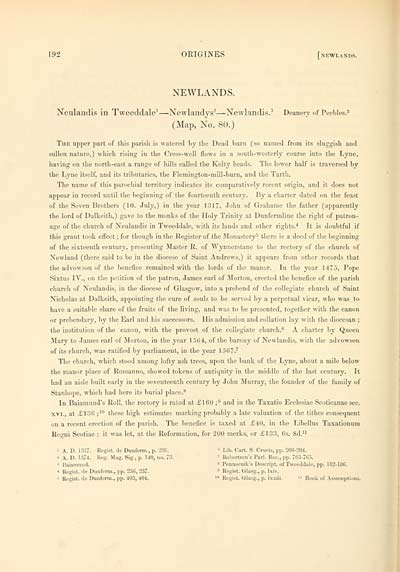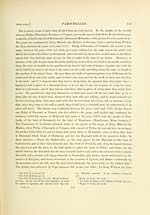Bannatyne Club > Origines parochiales Scotiae > Volume 1
(242) Page 192
Download files
Complete book:
Individual page:
Thumbnail gallery: Grid view | List view

192 ORIGINES [newlands.
NEWLANDS.
Neulandis in Tweeddale' — Newlandys' — Newlandis.^ Deanery of Peebles.^
(Map, No. 80.)
The upper part of this parish is watered by the Dead burn (so named from its sluggish and
sullen nature,) which rising in the Cress-well flows in a south-westerly course into the Lyne,
having on the north-east a range of hills called the Kelty heads. The lower half is traversed by
the Lyne itself, and its tributaries, the Flemington-mill-burn, and the Tarth.
The name of this parochial territory indicates its comparatively recent origin, and it does not
appear in record until the beginning of the fourteenth century. By a charter dated on the feast
of the Seven Brothers (10. July,) in the year 1317, John of Grahame the father (apparently
the lord of Dalkeitli,) gave to the monks of the Holy Trinity at Dunfermline the right of patron-
age of tlie church of Neulandis in Tweeddale, with its lands and other rights.* It is doubtful if
this grant took effect ; for though in the Register of the Monastery^ there is a deed of the beginning
of the sixteenth century, presenting Master R. of Wynnerstane to the rectory of the church of
Newland (there said to be in the diocese of Saint Andrews,) it appears from other records that
the advowson of the benefice remained with the lords of the manor. In the year 1475, Pope
Sixtus IV., on the petition of the patron, -James earl of Morton, erected the benefice of the parish
church of Neulandis, in the diocese of Glasgow, into a prebend of the collegiate church of Saint
Nicholas at Dalkeith, appointing the cure of souls to be served by a perpetual vicar, who was to
have a suitable share of the fruits of the living, and was to be presented, together with the canon
or prebendary, by the Earl and his successors. His admission and collation lay with the diocesan ;
the institution of the canon, with the provost of the collegiate church.^ A cliarter by Queen
Mary to -James earl of ]Morton, in the year 1564, of the barony of Newlandis, with the advowson
of its church, was ratified by parliament, in the year 1567.^
The church, which stood among lofty ash trees, upon the bank of the Lyne, about a mile below
the manor place of Romanno, showed tokens of antiquity in the middle of the last century. It
had an aisle built early in the seventeenth century by John Murray, the founder of the family of
Stanhope, which had here its burial place.^
In Baiamund's Roll, the rectory is rated at £160 ;^ and in the Taxatio Ecclesiae Scoticanae sec.
XVI., at £136;!* these high estimates marking probably a late valuation of the tithes consequent
on a recent erection of the parish. The benefice is taxed at £40, in the Libellus Taxationum
Regni Scotiae : it was let, at the Reformation, for 200 merks, or £133, 6s. Sd.^'
' A. D. 1317. Regist. de Dunferm., p. 236. « Lib. Cart. S. Crucis, pp. 200-204.
^ A. D. 1374. Reg. Mag. Sig., p. 140, no. 73. ' Robertson's Pari. Rec, pp. 763-765.
3 Baiamuud. ^ Penneeuik's Descript. of Tweeddale, pp. 182-136.
* Regist. de Dunferm., pp. 236, 237. " Regist. Glasg., p. Ixiv.
5 Regist. de Dunferm., pp. 403, 404. "> Regist. Glasg., p. Ixxiii. " Book of Assumptions.
NEWLANDS.
Neulandis in Tweeddale' — Newlandys' — Newlandis.^ Deanery of Peebles.^
(Map, No. 80.)
The upper part of this parish is watered by the Dead burn (so named from its sluggish and
sullen nature,) which rising in the Cress-well flows in a south-westerly course into the Lyne,
having on the north-east a range of hills called the Kelty heads. The lower half is traversed by
the Lyne itself, and its tributaries, the Flemington-mill-burn, and the Tarth.
The name of this parochial territory indicates its comparatively recent origin, and it does not
appear in record until the beginning of the fourteenth century. By a charter dated on the feast
of the Seven Brothers (10. July,) in the year 1317, John of Grahame the father (apparently
the lord of Dalkeitli,) gave to the monks of the Holy Trinity at Dunfermline the right of patron-
age of tlie church of Neulandis in Tweeddale, with its lands and other rights.* It is doubtful if
this grant took effect ; for though in the Register of the Monastery^ there is a deed of the beginning
of the sixteenth century, presenting Master R. of Wynnerstane to the rectory of the church of
Newland (there said to be in the diocese of Saint Andrews,) it appears from other records that
the advowson of the benefice remained with the lords of the manor. In the year 1475, Pope
Sixtus IV., on the petition of the patron, -James earl of Morton, erected the benefice of the parish
church of Neulandis, in the diocese of Glasgow, into a prebend of the collegiate church of Saint
Nicholas at Dalkeith, appointing the cure of souls to be served by a perpetual vicar, who was to
have a suitable share of the fruits of the living, and was to be presented, together with the canon
or prebendary, by the Earl and his successors. His admission and collation lay with the diocesan ;
the institution of the canon, with the provost of the collegiate church.^ A cliarter by Queen
Mary to -James earl of ]Morton, in the year 1564, of the barony of Newlandis, with the advowson
of its church, was ratified by parliament, in the year 1567.^
The church, which stood among lofty ash trees, upon the bank of the Lyne, about a mile below
the manor place of Romanno, showed tokens of antiquity in the middle of the last century. It
had an aisle built early in the seventeenth century by John Murray, the founder of the family of
Stanhope, which had here its burial place.^
In Baiamund's Roll, the rectory is rated at £160 ;^ and in the Taxatio Ecclesiae Scoticanae sec.
XVI., at £136;!* these high estimates marking probably a late valuation of the tithes consequent
on a recent erection of the parish. The benefice is taxed at £40, in the Libellus Taxationum
Regni Scotiae : it was let, at the Reformation, for 200 merks, or £133, 6s. Sd.^'
' A. D. 1317. Regist. de Dunferm., p. 236. « Lib. Cart. S. Crucis, pp. 200-204.
^ A. D. 1374. Reg. Mag. Sig., p. 140, no. 73. ' Robertson's Pari. Rec, pp. 763-765.
3 Baiamuud. ^ Penneeuik's Descript. of Tweeddale, pp. 182-136.
* Regist. de Dunferm., pp. 236, 237. " Regist. Glasg., p. Ixiv.
5 Regist. de Dunferm., pp. 403, 404. "> Regist. Glasg., p. Ixxiii. " Book of Assumptions.
Set display mode to: Large image | Transcription
Images and transcriptions on this page, including medium image downloads, may be used under the Creative Commons Attribution 4.0 International Licence unless otherwise stated. ![]()
| Publications by Scottish clubs > Bannatyne Club > Origines parochiales Scotiae > Volume 1 > (242) Page 192 |
|---|
| Permanent URL | https://digital.nls.uk/81025888 |
|---|
| Description | Volume first. Diocese of Glasgow. |
|---|---|
| Shelfmark | SCS.BC.97 |
| Additional NLS resources: | |
| Attribution and copyright: |
|
| Description | Place of publication Edinburgh unless otherwise stated. No. 125 is relative to but not part of the club's series. |
|---|---|

